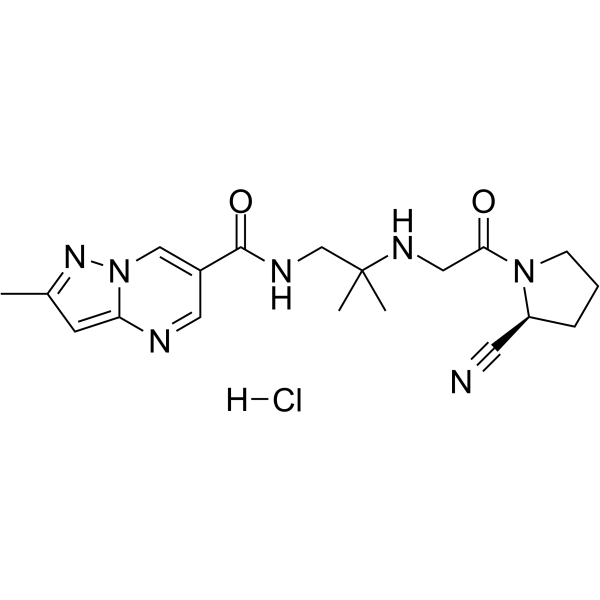1359670-56-6
| Name | N-[2-({2-[(2S)-2-Cyano-1-pyrrolidinyl]-2-oxoethyl}amino)-2-methylpropyl]-2-methylpyrazolo[1,5-a]pyrimidine-6-carboxamide hydrochloride (1:1) |
|---|---|
| Synonyms |
Pyrazolo[1,5-a]pyrimidine-6-carboxamide, N-[2-[[2-[(2S)-2-cyano-1-pyrrolidinyl]-2-oxoethyl]amino]-2-methylpropyl]-2-methyl-, hydrochloride (1:1)
N-[2-({2-[(2S)-2-Cyano-1-pyrrolidinyl]-2-oxoethyl}amino)-2-methylpropyl]-2-methylpyrazolo[1,5-a]pyrimidine-6-carboxamide hydrochloride (1:1) Anagliptin Impurity 4 |
| Description | Anagliptin (SK-0403) hydrochloride is a highly selective, potent, orally active inhibitor of dipeptidyl peptidase 4 (DPP-4), with an IC50 of 3.8 nM, and less selective at DPP-8 and DDP-9 with IC50s of 68 nM and 60 nM, respectively[1]. |
|---|---|
| Related Catalog | |
| Target |
DPP-IV:3.8 nM (IC50) DPP-9:60 nM (IC50) DPP-8:68 nM (IC50) |
| In Vitro | Anagliptin (SK-0403) (0-100 μM; 24 h) attenuates s-DPP-4-induced smooth muscle cells proliferation[2]. Anagliptin (100 μM; 10 min) reduces TNF-α production in cultured monocytes[2]. Anagliptin (0.001-10 μM; 24 h) significantly suppresses sterol regulatory element‐binding protein activity in HepG2 cells (21% decrease)[3]. Cell Proliferation Assay[2] Cell Line: Rat smooth muscle cells (SMC) Concentration: 1, 10 and 100 μM Incubation Time: 24 h Result: Attenuated s-DPP-4-induced SMC proliferation in a dose-dependent manner. Inhibited LPS-induced ERK phosphorylation and markedly suppressed LPS-induced nuclear translocation of NF-κBp65. Western Blot Analysis[2] Cell Line: Rat smooth muscle cells (SMC) Concentration: 100 μM Incubation Time: 10 min Result: Blocked the early- but not the late-phase ERK phosphorylation induced by s-DPP-4. |
| In Vivo | Anagliptin (SK-0403) (0.3%; in diet; 16 weeks) reduces atherosclerotic lesion and does not increase the number of circulating EPCs in apoliporotein E (apoE)-deficient mice[2]. Anagliptin (0.3%; in diet; 4 weeks) exhibits a lipid‐lowering effect in a hyperlipidemic mice model[3]. Animal Model: Male apoliporotein E (apoE)-deficient mice[2] Dosage: 0.3% Administration: In diet, 16 weeks Result: Reduced DPP-4 activity in the plasma as expected and did not affect food consumption or body weight gain. Significantly reduced total cholesterol level, especially VLDL and LDL-C without affecting triglyceride level. Also decreased the α-SMA-positive area within the individual plaque. Animal Model: Male low‐density lipoprotein receptor‐deficient mice (B6.129S7‐Ldlrtm1Her/J)[3] Dosage: 0.3% Administration: In diet, 4 weeks Result: Significantly decreased the plasma total cholesterol (14% reduction) and triglyceride levels (27% reduction). Significantly decreased low‐density lipoprotein cholesterol and very low‐density lipoprotein cholesterol. Sterol regulatory element‐binding protein‐2 messenger ribonucleic acid expression level was significantly decreased at night. Animal Model: Male Sprague–Dawley rats and Beagle dogs[1] Dosage: 0.2, 0.5, 1 and 10 mg/kg Administration: Oral or intravenous administration (Pharmacokinetic Studies) Result: Selected PK parameters of Anagliptin hydrochloride in rats and dogs[1] Compound Species CLtot (l/h/kg) Vdss (l/h/kg) Cmaxc (ng/ml) Tmaxc (h) T1/2 (h) AUC (ng/h/ml) BA (%) Anagliptin hydrochloridea Rat 2.00 (iv) 0.68 (iv) 309 (62) (po) 0.8 (2.3) (po) 1.9 (po) 1160 (po) 23 (po) Dog 0.65 (iv) 0.83 (iv) 261 (po) 1.5 (po) 1.0 (po) 824 (po) 100 (po) aAnagliptin hydrochloride dose in rats, 1 mg/kg, iv (n = 3); 10 mg/kg, po (n = 3). 4a dose in dogs, 0.2 mg/kg, iv (n = 3); 0.5 mg/kg, po (n = 2).cValues in parentheses were obtained at a dose of 3 mg/kg (n = 3). |
| References |
| Molecular Formula | C19H26ClN7O2 |
|---|---|
| Molecular Weight | 419.908 |
| Exact Mass | 419.183655 |
